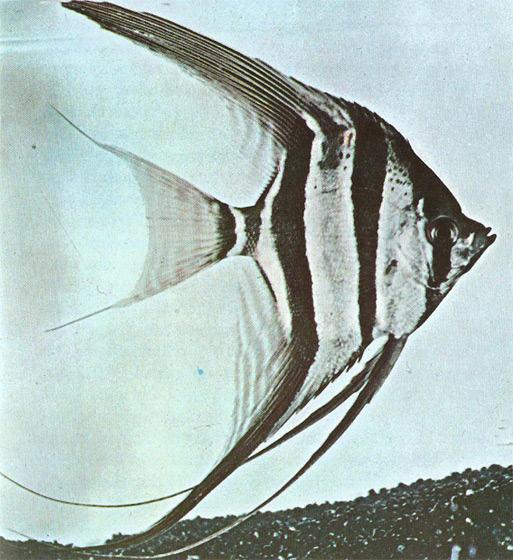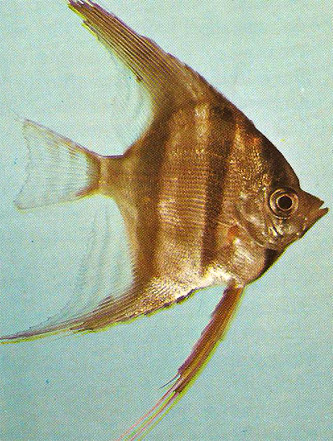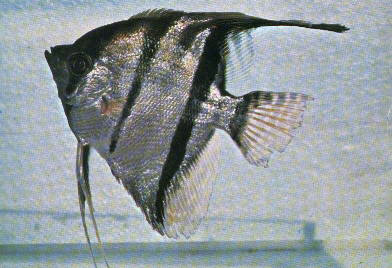
Fig. 1. The
second species of angelfish, P. dumerilii,
with the characteristic black spot at the
base of the dorsal fin.
|
| The
second species of angelfish, P. dumerilii,
with the characteristic black spot at the
base of the dorsal fin. |
Dr. L. P. Schultz, in his 1967 "Review of South American
Freshwater Angelfishes-Genus Pterophyllum" (Proc. USNM, Vol.
120, #3555) came to the conclusion that there were at least two
species (P. scalare and P. dumerilii) in the genus, with a third
(P. altum) as possible. The dubious species, P. altum, according
to Dr. Schultz, had a color pattern identical with that of P.
scalare, but different on the basis of counts. He concluded
that, "undoubtedly P. altum represents the P. scalare type of
angelfish in the upper Orinoco, and in having a higher average
number of dorsal, anal, oblique scale rows and vertebrae than P.
scalare, it might be considered to represent only a subspecies
of P. scalare: however, since P. altum has been taken so far
only in the upper Orinoco basin, I prefer tentatively to
recognize it as a distinct species."
In Dr. Axelrod's recent collection from Igarape Anapichi and
Igarape Apania of the Rio Negro, nine specimens of angelfish,
varying in size from 28.4 mm to 101.5 mm standard length, were
brought back for examination. The specimens were undoubtedly not
P. dummerilii on the basis of color pattern and counts, but the
identification with either P. altum or P. scalare was uncertain.
In fact, the counts seemed to be intermediate between the two
forms.

Fig.
2. Map of the Amazon basin showing selected areas of the angelfishes' range (1-11).
|
| Fig. 2 Map of the Amazon basin showing selected areas of the angelfishes' range (1-11). |
They ranged from 25 to 27 rays in the dorsal fin and 27 to 30
rays in the anal fin. All had VI anal fin spines, and eight of
the nine had XII dorsal fin spines. The ninth had XIII spines.
The scale rows ranged from 34-43 from the rear of the head to
the midbase of the caudal fin. In P. altum there are reported
XI-XIII dorsal fin spines (though normally XII) with 27-31
dorsal fin rays (mostly 28), and VI anal fins spines with 28-32
rays (usually 29-30). P. scalare had XI-XIV dorsal fin spines
(mostly XII or XIII) with 21-28 rays (mostly 22-26) and V-VII
(usually VI ) anal fin spines with 22-30 rays (mostly 24-28). It
had 28-44 scale rows (more normally 31-39). Since Schultz gave
the number of specimens from each locality for each of the
counts in his Table 3, it was an easy matter to plot the mean of
the counts from each locality on a map and compare them (Fig. 2
above).

Fig.
3. A wild
caught angelfish from the Orinoco River.
This is the Pterophyllum altum of Schultz.
|
| A wild
caught angelfish from the Orinoco River.
This is the Pterophyllum altum of Schultz. |
The results of this graphic representation were quite
interesting. In proceeding up the Amazon River from Santarem
through Manaus to the Rio Negro and on to the Orinoco, the mean
number of dorsal and anal fin rays and scale rows increased. The
specimens in the Manaus to Tefe area were almost alike in these
counts, but moving upstream in the Solimoes system to the
Peruvian Amazon the counts decreased again. Heading to the
Atlantic coast from Santarem there is another increase in mean
counts. The Guyana specimens agreed quite well with the Porto do
Moz specimens. Right: A wild caught angelfish from the Orinoco
River. This is the Pterophyllum altum of Schultz. It appears,
then, that P. altum is the end of a cline of the Rio Negro
populations of P. scalare. Another group of 6 specimens taken
above the Igarape Anapichi and Igarape Apania region, which were
identified as P. altum, had counts which fell nicely into this
clinal sequence (see fig. 1).

Fig.4
Captured farther up the Rio
Negro (proceeding in a
northwesterly direction along
the Rio Negro from Manaus).
|
| Captured
farther up the Rio Negro (proceeding in a
northwesterly direction along the Rio Negro
from Manaus). |
On the basis of these findings it seems that there are only
two valid species in the genus Pterophyllum.. P. scalare and P.
dumerilii, with P. altum not valid. P. dumerilii is sympatric
with P. scalare and differs in color pattern. There are
generally fewer dorsal and anal fin rays (D. XI-XIII, 18-24, but
usually 19-21; A. VI, 19-28, but usually 20-22), and fewer scale
rows 26-33 (but usually 27-31).
Wild-caught angelfish taken from
the Rio Negro at different points in the river. The fish to the
left (Fig.4) was captured a two-days journey farther up the river
(proceeding in a northwesterly direction along the Rio Negro
from Manaus) than the fish below-right (Fig. 5), which was caught in the area of Igarape Anapichi and Igarape Apania.

Fig. 5
Caught in the area of Igarape Anapichi and Igarape Apania.
|
| Caught in
the area of Igarape Anapichi and Igarape Apania. |
Because of Dr. Axelrod's report on the short anal fin, I
examined the rays carefully under a microscope. It seems fairly
certain that the trailing anal rays and sometimes the caudal and
pelvic rays were torn or bitten off and have started to
regenerate. When I explained this to Dr. Axelrod he surmised
that the exceptionally high waters conjugated the habitats of
the angelfish with those of the piranhas, thus enabling the
piranhas to bite off their long trailing anal fins. Normally the
two habitats are distinct and these physical anomalies are not
apparent. |